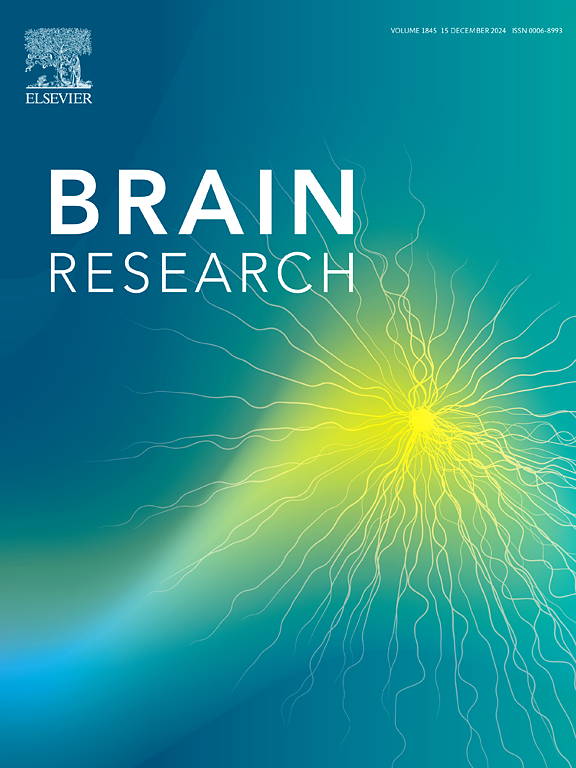孕期补充柚皮苷会改变大鼠后代的大脑氧化还原系统和线粒体功能
IF 2.7
4区 医学
Q3 NEUROSCIENCES
引用次数: 0
摘要
众所周知,在使用成年啮齿动物的疾病模型中,补充柚皮苷可改善中枢神经系统(CNS)的氧化应激,并改善认知功能。然而,如果在发育的关键时期补充柚皮素,是否仍然有益?为了解决这个问题,我们利用怀孕的 Wistar 大鼠,在妊娠期间每天补充柚皮苷(100 毫克/千克)。分娩后,幼鼠在出生后第 1、7 和 21 天被安乐死。解剖前额叶皮层、海马、纹状体和小脑,以评估氧化还原系统和线粒体功能。我们的数据表明,在妊娠期给妊娠大鼠补充柚皮苷对所分析的大脑结构产生了不同的影响,导致氧化还原平衡失调,主要是在 PND1 期。后代小脑在 PND1 发现的氧化还原和线粒体变化在 PND7 也被观察到,并持续到 PND21,这表明该结构更容易受到母体柚皮苷补充剂引发的影响。与在小脑中观察到的情况相反,我们发现从PND1到PND21,前额叶皮层、海马和纹状体的改变数量逐渐减少,这表明这些大脑结构不像小脑那样容易受到柚皮苷的影响。因此,我们的研究结果表明,母体在怀孕期间补充柚皮苷可能会对后代的大脑,尤其是小脑产生负面的编程效应。本文章由计算机程序翻译,如有差异,请以英文原文为准。

Naringin supplementation during pregnancy alters rat offspring’s brain redox system and mitochondrial function
Naringin supplementation is known to ameliorate oxidative stress in the central nervous system (CNS) and improve cognitive function in disease models using adult rodents. However, if this supplementation is applied during critical periods of development, would it still be beneficial? To address this question, we used pregnant Wistar rats that were supplemented daily with naringin (100 mg/kg) during gestation. After delivery, pups were euthanized on postnatal day (PND) 1, 7, and 21. The prefrontal cortex, hippocampus, striatum, and cerebellum were dissected for redox system and mitochondrial function evaluation. Our data demonstrated that naringin supplementation to pregnant rats during gestation differentially affected the brain structures analyzed, inducing a dysregulation in the redox homeostasis, mainly on PND1. Redox and mitochondrial alterations found in offspring’s cerebellum on PND1 were also observed on PND7, and persisted up to PND21, indicating a higher susceptibility of this structure to the effects triggered by maternal naringin supplementation. In contrast to what was observed in the cerebellum, we found a progressive decline in the number of alterations in the prefrontal cortex, hippocampus, and striatum from PND1 up to PND21, suggesting that these brain structures are not as susceptible as the cerebellum to the naringin’s effects. Thus, our findings demonstrate a possible negative programming effect triggered by maternal naringin supplementation during pregnancy in the offspring’s brain, especially in the cerebellum.
求助全文
通过发布文献求助,成功后即可免费获取论文全文。
去求助
来源期刊

Brain Research
医学-神经科学
CiteScore
5.90
自引率
3.40%
发文量
268
审稿时长
47 days
期刊介绍:
An international multidisciplinary journal devoted to fundamental research in the brain sciences.
Brain Research publishes papers reporting interdisciplinary investigations of nervous system structure and function that are of general interest to the international community of neuroscientists. As is evident from the journals name, its scope is broad, ranging from cellular and molecular studies through systems neuroscience, cognition and disease. Invited reviews are also published; suggestions for and inquiries about potential reviews are welcomed.
With the appearance of the final issue of the 2011 subscription, Vol. 67/1-2 (24 June 2011), Brain Research Reviews has ceased publication as a distinct journal separate from Brain Research. Review articles accepted for Brain Research are now published in that journal.
 求助内容:
求助内容: 应助结果提醒方式:
应助结果提醒方式:


